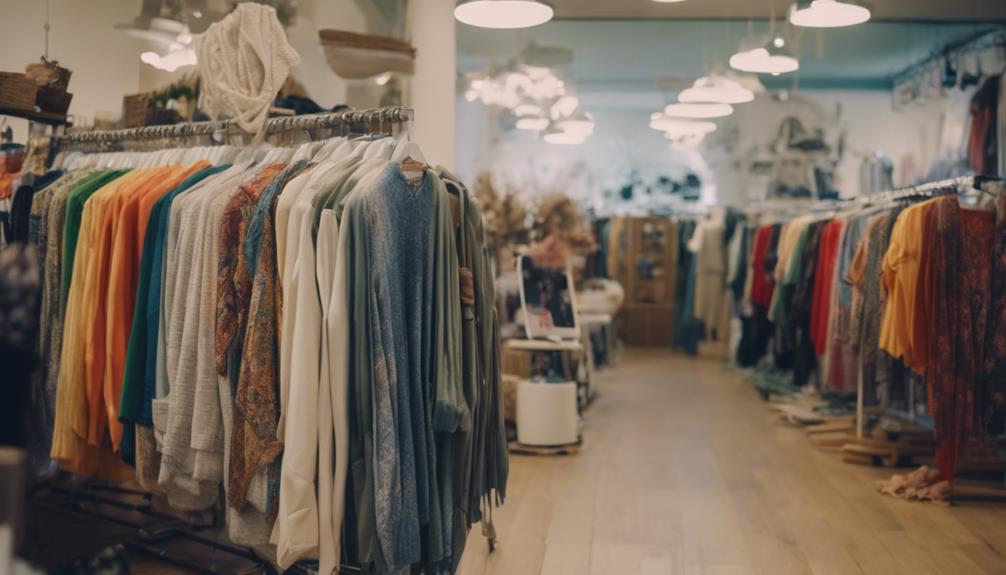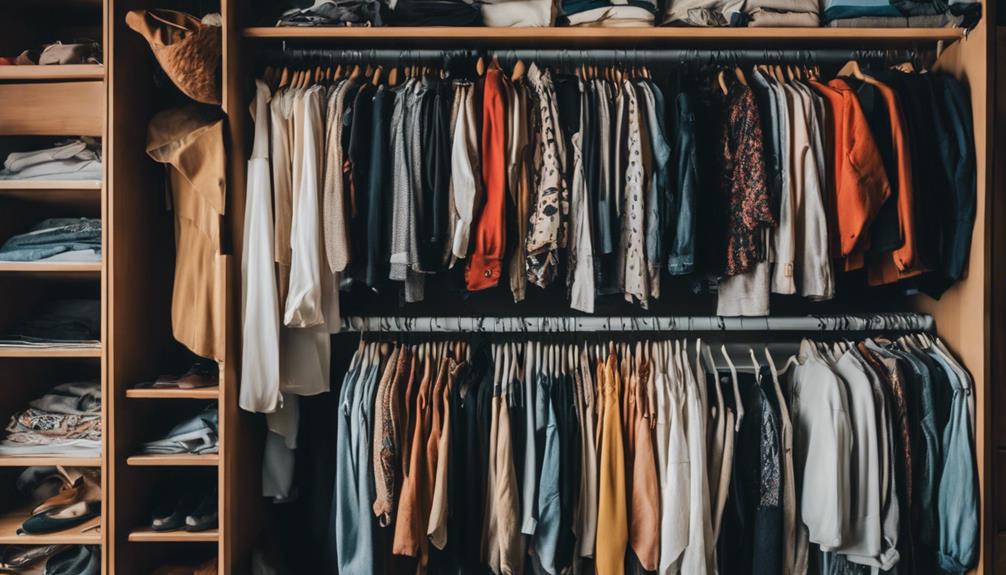In the United States, sustainable fashion may initially appear pricey, but the truth will amaze you. Higher costs are a reflection of ethical sourcing, fair labor practices, and eco-friendly materials. While a sustainable garment may have a higher price tag upfront, consider its longevity. For example, a $90 sustainable piece worn 30 times costs only $3 per wear. Compare that to fast fashion, where you pay $5 per wear for something inexpensive that doesn’t last. Ultimately, investing in sustainable fashion not only benefits the environment but is also more cost-effective in the long term. Curious to learn more about its unexpected advantages?
Key Takeaways
- Sustainable fashion often has higher upfront costs due to eco-friendly materials and ethical labor practices.
- The average cost-per-wear of sustainable garments decreases significantly when worn multiple times, making them more economical in the long run.
- Investing in sustainable fashion promotes responsible manufacturing, reducing clothing waste and supporting fair labor practices.
- Circular business models related to sustainable fashion are projected to generate significant economic opportunities, reaching $560 billion by 2030.
Understanding Sustainable Fashion Pricing
Understanding sustainable fashion pricing starts with recognizing that higher costs often reflect ethical sourcing and fair labor practices, setting it apart from fast fashion's lower-priced, exploitative model.
When you choose sustainable fashion, you're investing in clothing that prioritizes workers' rights and uses sustainable materials, which can lead to a higher price tag. This approach aims to reduce the environmental footprint associated with the fast fashion supply chain.
As a consumer, you might spend around $526.50 on clothing every year, yet you only wear about 10% of your wardrobe regularly. This brings up the issue: is it worth investing in higher-priced, high-quality sustainable items?
Absolutely! Sustainable fashion emphasizes durability and longevity. For instance, a $90 sustainable garment worn 30 times only costs you $3 per wear, compared to a cheap fast fashion piece worn just twice for $5 per wear.
Factors Influencing Cost

Several key factors drive the higher costs associated with sustainable fashion, making it distinct from conventional clothing options.
First, eco-friendly materials like organic cotton are often more expensive to produce than traditional fabrics, impacting the overall price tag.
Next, ethical labor practices play a significant role; brands committed to fair trade principles guarantee workers receive decent wages and safe working conditions, which naturally increases costs.
Additionally, sustainable production methods require investment in technology and research, raising initial expenses compared to mass-produced fast fashion items. The emphasis on small-scale production also contributes to higher per-unit costs. Sustainable brands often adopt made-to-order models to reduce fashion waste, resulting in a higher price for consumers.
Lastly, certifications for sustainability further elevate costs. Brands invest in third-party validation to differentiate themselves from greenwashing and build consumer trust, adding to the overall price.
These factors combined explain why sustainable fashion carries higher price tags but also reflects a commitment to more responsible and eco-friendly practices.
In the long run, choosing sustainable products supports ethical practices and a healthier planet.
Comparing Sustainable and Fast Fashion

When you compare sustainable and fast fashion, you'll notice that the upfront costs of eco-friendly options often reflect their commitment to ethical practices and quality materials. While fast fashion may seem budget-friendly, it comes with hidden costs, such as environmental damage and unfair wages for workers.
Here's a quick comparison:
| Feature | Sustainable Fashion | Fast Fashion |
|---|---|---|
| Upfront Cost | Higher due to eco-friendly materials | Lower initial price |
| Life-Cycle of a Product | Designed for longevity | Often discarded quickly |
| Environmental Impact | Lower carbon emissions | Contributes to 10% of global carbon emissions |
Investing in sustainable fashion means you're choosing clothing that lasts longer and has a reduced environmental impact. You're also supporting ethical labor practices, ensuring that workers are paid fairly. A cost-per-wear analysis shows that sustainable garments can actually be more economical over time. As more consumers recognize these benefits, the willingness to pay more for sustainable brands continues to grow. By making better choices, you not only enhance your wardrobe but also contribute positively to the planet.
Benefits of Investing in Sustainability

Investing in sustainable fashion not only reduces clothing waste but also promotes ethical labor practices and contributes to a healthier planet. By choosing clothes made from eco-friendly materials, you directly support a supply chain that prioritizes environmental and ethical standards. This commitment leads to better working conditions, ensuring that workers receive fair wages and operate in safe environments.
When you make conscious fashion choices, you help decrease the fashion industry's significant impact on greenhouse gas emissions, which currently account for about 10% of global emissions. Extending the lifespan of your garments by just nine months can lower environmental impact by 30%, demonstrating how your decisions can lead to meaningful change.
Though sustainable fashion items may have a higher upfront cost, they often lead to savings over time due to a lower cost-per-wear. For instance, a $90 sustainable garment worn 30 times costs you only $3 per wear.
With the sustainable fashion market projected to reach $33.05 billion by 2030, your investment not only promotes ethical and sustainable practices but also supports a shift towards a more responsible fashion industry.
Long-Term Financial Implications

The long-term financial implications of choosing sustainable fashion can lead to significant savings, as durable garments often reduce the cost per wear compared to cheaper, less resilient options.
For instance, investing in a $90 sustainable piece worn 30 times translates to just $3 per wear, whereas a $10 fast fashion item worn twice costs $5 per wear. By prioritizing clothing durability, you can reduce overall spending and maximize the value of each purchase.
Moreover, the average consumer spends around $526.50 annually on clothing but typically wears only 10% of their wardrobe. This presents an opportunity to save money by selecting versatile, sustainable pieces that stand the test of time.
Engaging with sustainable fashion also opens doors to economic opportunities, like the growing textile recycling market, projected to reach $5.3 billion by 2030.
Embracing circular business models within fashion brands could generate an estimated $560 billion in economic opportunities.
Ultimately, the long-term financial benefits of sustainable fashion not only contribute to your wallet but also help reduce the overall environmental impact of your clothing choices.
Consumer Responsibility and Impact

Sustainable fashion places significant responsibility on you as a consumer, urging you to make mindful choices that impact both the environment and the economy. You can shape the global fashion market by prioritizing sustainable clothing and supporting fashion companies that uphold human rights and ethical practices.
While you might pay a premium for these items, remember that investing in quality reduces waste and fosters a more responsible manufacturing process. Consider the benefits of buying less but choosing well.
Here's a quick comparison to visualize your impact:
| Sustainable Fashion | Fast Fashion |
|---|---|
| Higher price, longer wear | Lower price, shorter use |
| Supports ethical practices | Often exploits workers |
| Minimizes waste | Contributes to landfills |
| Promotes recycling | Little to no recycling |
Frequently Asked Questions
How Much More Does Sustainable Fashion Cost?
Sustainable fashion often costs 2-3 times more than fast fashion, with average garments around $90 compared to $10. However, investing in quality pieces can save you money over time through durability and cost-per-wear efficiency.
How Much Cheaper Is Fast Fashion Than Sustainable Fashion?
You might think fast fashion's prices are shockingly low like a dollar store treasure hunt, but those $5 tops come at a hefty environmental cost, while sustainable pieces offer lasting value and ethical production behind their higher price tags.
Will Consumers Pay More for Sustainable Fashion?
Yes, you're likely to pay more for sustainable fashion. Many consumers prioritize eco-friendly options, showing a willingness to invest in ethically produced garments, despite some skepticism about sustainability claims and perceived value.
Does Sustainable Fashion Really Work?
Yes, sustainable fashion works! You're investing in quality pieces that last longer, reducing waste and environmental impact. By choosing eco-friendly materials and ethical practices, you're supporting a healthier planet and promoting a circular economy.
What is the Cost of Sustainable Fashion and How Does it Impact the Economy?
The impact of sustainable fashion on the economy is significant. While the initial cost of sustainable fashion may be higher, in the long run, it can lead to reduced production and consumption costs. Additionally, it can create jobs in the sustainable fashion industry and contribute to a more environmentally friendly economy.
Conclusion
In the end, investing in sustainable fashion isn't just about the price tag; it's about the quality you receive, the ethical standards you support, and the planet you protect.
You're not just buying clothes; you're choosing a lifestyle, embracing responsibility, and making a statement.
By prioritizing sustainability, you're contributing to a better future, supporting fair labor practices, and reducing waste.
So, when you consider the cost, remember: it's an investment in yourself and the world around you.









